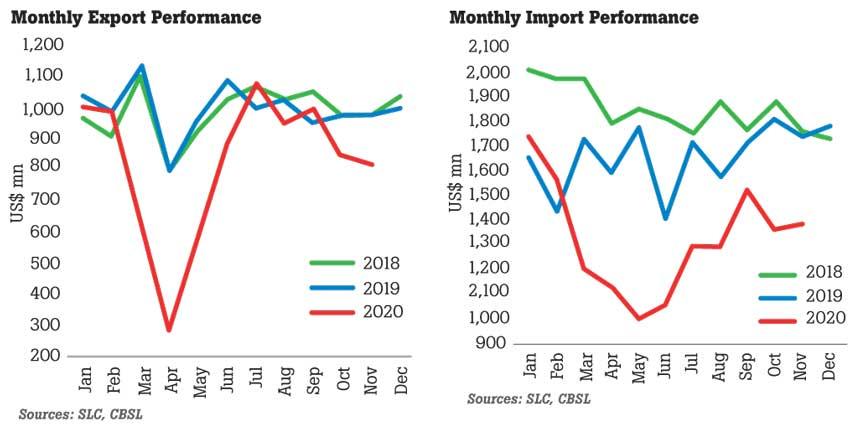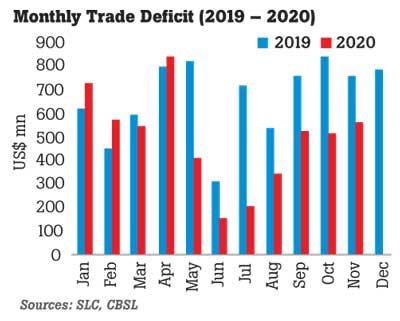16 Jan 2021 - {{hitsCtrl.values.hits}}

Sri Lanka’s external sector performance continued to improve in November with the trade deficit narrowing further, mainly due to the restrictions imposed on non-essential imports and the lower fuel bill, despite the second COVID-19 wave taking a toll on the export revenue.
In November, Sri Lanka recorded a US $ 565 million deficit in the trade account, which was considerably lower than the deficit of US $ 762 million recorded in November 2019.

However, the country’s trade deficit slightly picked up in November, compared to October, when the country’s trade deficit was down to US $ 514 million.
The improvement in the trade balance was due to the decline in imports by US $ 453 million, which was greater than the US $ 129 million decline in exports.
The cumulative deficit in the trade account in the 11-month period narrowed by around US $ 1.7 billion to US $ 5.42 billion, from the deficit of US $ 7.21 billion recorded in the same period in 2019.
The biggest contributing factors for the narrowing of the trade deficit were over US $ 1.2 billion decline in fuel imports, over US $ 560 million decline in textile and textile article imports, US $ 460 million decline in building material imports and almost US $ 450 million decline in personal vehicle imports.
Meanwhile, Sri Lanka’s exports in November fell 16.3 percent from a year ago to US $ 819 million, affected by the resurgence of COVID-19 in the country from early October as well as the spike in COVID-19 cases in the country’s key export markets.
“The measures imposed to combat the second wave of the pandemic locally affected production in key export sectors, garments in particular. Further, the second wave of the pandemic experienced in export markets affected demand for exports, while significant disruptions to global shipping and logistical chains also affected local businesses negatively,” the Central Bank (CB) said.
The industrial exports in November fell 19.6 percent from a year ago to US $ 632.9 million, as textile exports fell by a record 37.2 percent year-on-year (YoY) to US $ 281.4 million, which was mainly due to the health-related restrictions imposed in these manufacturing plants.
In addition, earnings from the export of petroleum products contracted by a record 62.4 percent YoY to US $ 21.3 million in the month, due to the reduction in bunkering quantities as well as prices.
“While exports of a number of smaller factory-based export sectors also declined, export earnings from some industrial export categories increased. The latter included gems, diamonds and jewellery; rubber products (with increased exports of tyres and gloves) and plastics and articles thereof (with increased exports of personal protective equipment such as plastic clothing articles),” the CB noted.
The earnings from agricultural exports declined by 2.3 percent YoY to US $ 183.1 million in November, due to a reduction in the export of tea, seafood and minor agricultural products (fruits, edible nuts, betel leaves, etc.) In the month, tea exports fell by 5.2 percent to US $ 96.2 million, with declines in volumes of black and green tea exported, despite the marginal increases in unit prices of both types. However, spices (led by cinnamon and pepper), coconut (mainly coconut oil and non-kernel products) and rubber show increases in export revenue in the month. In particular, natural rubber exports increased by 180 percent to US $ 3.2 million.
The cumulative export earnings for the 11 months of the year fell 16.7 percent to US $ 9.1 billion.
Meanwhile, import expenditure in November fell 20.5 percent from a year ago to US $ 1.38 billion, with all three main import categories recording declines.
Sri Lanka’s fuel import bill in November nearly halved by 44 percent YoY to US $ 178.9 million, which in turn was due to the reduction in oil prices in the world market.
“The average import price of crude oil in November 2020 was US $ 45.88 per barrel, in comparison to US $ 69.11 per barrel in November 2019. Volumes imported of crude oil slightly increased in November 2020, compared to November 2019, while volumes of refined petroleum and coal imports declined,” the CB noted.
Sri Lanka’s overall oil import bill up to November last declined by 35.2 percent YoY to US $ 2.3 billion.
The import expenditure on investment goods, which includes machinery and equipment, building material and transport equipment, declined by 18.1 percent YoY to US $ 309.4 million in November. “Large value reductions were apparent in articles of iron and steel, medical and laboratory equipment, commercial purpose vehicles, cement, ceramic products, machinery and equipment parts and uncategorised industrial machinery and transport equipment. However, notable increases in import expenditure were observed with iron and steel, computers, transmission apparatus, agricultural machinery and tractors,” the CB highlighted. The cumulative import expenditure on investment goods fell by 22.5 percent YoY to US $ 3.2 billion in the 11 months of 2020. Meanwhile, the country’s major inflows to the current account, workers’ remittances, continued to increase for the sixth consecutive month. This increase led cumulative workers’ remittances to record a 3.9 percent growth YoY to receive US $ 6.23 billion in foreign exchange inflows to the country in the 11-month period.
20 Nov 2024 26 minute ago
20 Nov 2024 33 minute ago
20 Nov 2024 2 hours ago
20 Nov 2024 2 hours ago
20 Nov 2024 3 hours ago